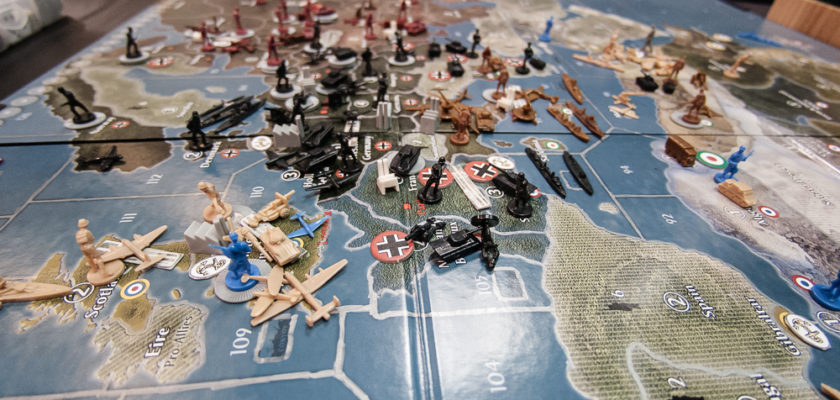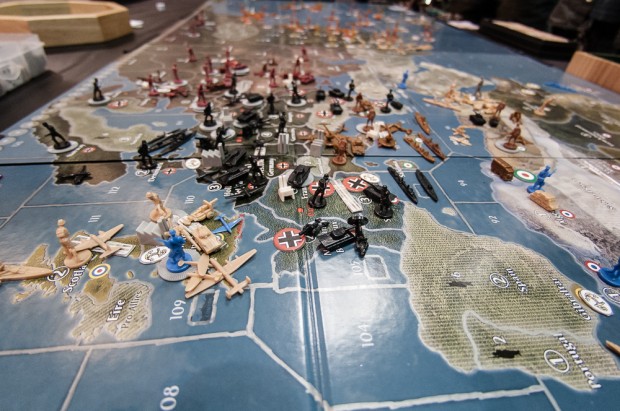Written by Young Grasshopper at Axisandallies.org on December 26th, 2012. Compiled and Edited by Rorschach of I Will Never Grow Up Gaming.
The invitation.
OK, so you’ve been invited to play a game of Axis and Allies 1940 Global with a few of your friends, however, there’s just one problem; you don’t know a thing about it!
Well don’t worry, we’re going get you up to speed so you can feel comfortable around the gaming table. This should also help your friends by relieving some of the stress involved when teaching such a complicated game. Keep in mind that this article is just a short primer; more like a briefing than a full fledged tutorial.
What is Axis and Allies?
Axis and Allies a World War 2 strategy board game which has a lot of small poker chips, plastic miniature figures, cardboard counters, 6 sided dice, and one massive map of the world.
It helps if you have had experience playing strategy board games like Chess, or Risk, but it’s not necessary. A little knowledge of World War 2 would also come in handy. Basically you rewrite the history books by playing the roles of some of the most powerful leaders of the century while changing the events of the Second World War…. Awesome right?
A brief history of Axis and Allies.
Axis and Allies is a huge franchise of war strategy games created by Larry Harris. The phenomenon began with the first edition released in the early 1980’s by Milton Bradley. Since then, there have been many, many subsequent variants published by Avalon Hill, and Wizards of the Coast including the game you are learning today : Axis & Allies 1940 Global 2nd Edition, which from here on in will be referred to simply as A&A.
The participants.
In A&A there are major powers like Germany and The United Kingdom, and minor powers like France and China. Before the game the experienced players will divide the nations among everyone in a way that is fair. It’s quite normal for 1 player to control up to 3 nations, while a new player is given 1 to handle. There are a total of 9 Nations in A&A, and one of the most important things to remember is, none of them are on even terms. Some begin the game with more units than others, some begin the game with more money than others, and some don’t even get to fight right away. Learn only the nation you have been chosen to play, who your teammates are, where your capital is, how much money you start with, and what your national objectives are.
The order of play.
In A&A, there are a lot of things that have already been predetermined, such as the setup of starting units, the amount of starting income, the relationships between players/nations, and the order of play. At the beginning of every game, Germany will begin their turn sequence. Chances are this will not be you! Germany is arguably the most difficult nation to play, and quite possibly the most fun.
Regardless, the order of each round of play is as follows; Germany, U.S.S.R, Japan, U.S.A, China, United Kingdom, Italy, ANZAC, France.
The turn sequence.
In every game, during every round, for every nation, a specific turn sequence must be followed. Using Germany as an example, we are going to go through the turn sequence together…. ready?
#1- Research & Development – It is recommended that you don’t attempt this in your first game, for simplicities sake
#2- Repair Damaged Units – spend money to repair capital ships & facilities.
#3- Purchase New Units – look at everything available to buy, decide what you think you will need at the end of your turn, and place it to the side (they don’t go on to the game board until the end of your turn).
#4- Combat movement – this is the most difficult phase in the whole sequence.
#5- Resolve combat – take over (or at least attempt to take over) territories, and sea zones occupied in step #4 by rolling dice.
#6- Non-Combat Movement – move any unit that was not already moved, or is required to move after combat.
#7- Place New Units – spawn the units that you bought in step 3 on any eligible territory or sea zone.
#8- Collect Income – get money for all territories, national objectives, and conquered capitals.
There are different strategies by different types of players, that said, here is an example of Germany’s first turn…
Research & Development
None
Repair Units & Facilities
None
Purchase New Units:
1 Strategic Bomber
1 Fighter
1 Destroyer
Combat Movement:
SZ#106 – 1 Submarine
SZ#110 – 2 Submarines, 1 Battleship, 2 Fighters, 2 T.Bombers, 1 S.Bomber
SZ#111 – 2 Submarines, 2 Fighters, 1 T.Bomber, 1 S.Bomber
France – 7 Infantry, 4 M.Infantry, 3 Artillery, 3 Tanks
Baltic States – 3 Infantry, 2 Tanks, 1 T.Bomber
Eastern Poland – 2 Infantry. 3 Tanks
Bessarabia – 2 Infantry, 1 Tank, 1 Fighter, 1 T.Bomber
Non-Combat Movement:
1 Cruiser, 1 Transport into SZ#113 / 2 Infantry from Germany into Norway
3 Infantry from Norway into Finland
3 Infantry from Germany into W.Germany
6 Infantry, 3 Artillery, 1 AA Gun from Germany into Poland
6 Infantry, 2 Artillery, from S.Germany into Slovakia
1 AA Gun from Germany into Slovakia
1 AA Gun from Germany into W.Germany
3 AA Guns from W.Germany into N.Italy
1 T.Bomber from Poland into Poland
1 T.Bomber from Germany into Poland
1 Fighter from Slovakia into Slovakia
All surviving air units from the Atlantic into W.Germany
Place new units:
1 Strategic Bomber into W.Germany
1 Fighter into W. Germany
1 Destroyer into SZ#113
Collect income:
$38 income
$5 National objective
$19 Capital gain
= $62
Now before you start freaking out, and thinking about how you’re gonna get out of this game, just remember that you won’t have to deal with these kinds of decisions your first time. If the circumstances are right, you will be given a small role with lots of advice from more experienced teammates. There will be plenty of time between turns to evaluate the board, read the materials, and ask for help.
The unit profiles and details.
There are many different units that can be purchased, and placed on the board to ultimately support your war effort. Some units fight on land to take over valuable territories, some fight on sea to strategically strengthen your position, and some have no combat value at all, but can allow extended movement, or better spawning locations. What ever unit you buy, remember that it has many attributes and rules that are specific to them only. However, the only thing you need to know in your first game is… how much does it cost, how far can it move, what is it’s attack value, and what is it’s defense value. Luckily for you, all this information is displayed on charts in both lower corners of the game board.
Your teammates will help you with many of the complicated rules associated with each unit, however, you will be doing them a great service if you can learn the basic statistics of each unit by using the charts provided.
A&A game plans and strategies
To put it in its most basic terms your role in the game is to take new territories while keeping the ones you already own. After that, you should just try and have fun. That said, remember this: experienced A&A players are a weird species. We have played, and talked about this game to death. Don’t let us play your nation for you by telling you what to buy, where to move, what to attack, and with what. Ask us to explain all your options, and then choose one with conviction. Understand that there is no “one way” to play this game! My Germany turn 1 blueprint above for example is widely unpopular with other experienced players, but I play it every chance I get.
There is one truth to this game, and that is “there are no perfect plans”, and if there were, they would get humbled by simple mistakes, or angry dice gods (I told you we are weird).
A&A game etiquette
When invited to play A&A at someone’s house try to be mindful of some bad habits that most new players fail to correct.
In A&A, you will be required to roll lots of dice. Try to do this quickly and efficiently. You know.. without throwing them hard and wiping out pieces on the board, or constantly dropping them on the floor. Try and find a small box to roll in if one is not provided, and confirm how many dice to roll before you toss them.
Keep a clean play area. If you have a minute between turns (and chances are you will), put your casualties back in your parts tray, and keep your drink on a separate table beside you.
Don’t get mad over poor dice rolls! Everyone knows that you can’t control the outcome of the dice, so don’t behave like you can.
And finally, don’t be a dick! If you are trash talking too much, over celebrating your rolls, or blaming team mates for loses, they won’t invite you back to play the best board game ever, and you will end up alone in the online game forums (where the really weird ones play).
Summary:
This could be the beginning of a life long obsession that could turn you into an elite strategist. Embrace it and understand that you are playing a highly popular game franchise that has sold millions of copies world wide. Watch some youtube videos that explain the basics of the game (BGRWJ 002 is a good one). Also maybe watch some World War 2 documentaries to get you in the mood. Nothing makes me want to play quite like watching footage of Rommel cutting across Africa, the great Marianas turkey shoot, or the Battleship Hood and Bismarck stand off.
Perhaps after reading this, you will become compelled to download the rule book from wizards.com, or maybe I have made you run away to never speak of this game again! What ever you do, good luck and most of all, HAVE FUN!



